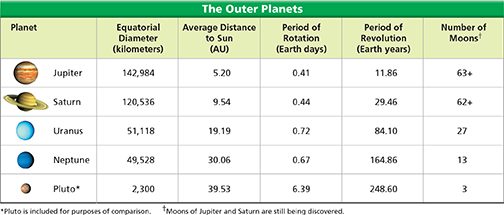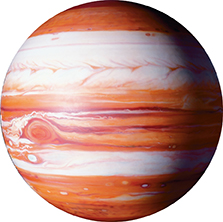Gas Giants
Jupiter, Saturn, Uranus, and Neptune are very different from the terrestrial planets. They are much colder because of their greater distance from the sun. All four planets are much larger and more massive than the terrestrial planets. They are composed mainly of hydrogen and helium, which is why they are often referred to as the gas giants.
None of the gas giants have solid surfaces. If you tried to land a spaceship on one, you would sink into the planet until the intense pressure of the atmosphere crushed the ship. In fact, the pressure is so great inside each planet that hydrogen and helium exist mostly in liquid form.
 The four gas giants are thought to have small, dense cores, and thick atmospheres that are mostly hydrogen and helium.
The four gas giants are thought to have small, dense cores, and thick atmospheres that are mostly hydrogen and helium.
Each gas giant resembles a miniature solar system. They have many moons, most of which revolve in the same direction that the planets rotate. Each of the gas giants is surrounded by rings. A ring is a disk made of many small particles of rock and ice in orbit around a planet. Such rings are so close to the planet that gravitational forces are very large. These forces may have prevented the ring particles from clumping together to form moons. The characteristics of the gas giants and the dwarf planet Pluto are summarized in Figure 20.
Jupiter
Jupiter, shown in Figure 21, is the first planet beyond the asteroid belt. Named for the ruler of the Roman gods, Jupiter is large enough to hold more than 1300 Earths.
 Jupiter is the largest and most massive planet in our solar system. Like the other gas giants, Jupiter is composed mainly of hydrogen and helium.
Jupiter is the largest and most massive planet in our solar system. Like the other gas giants, Jupiter is composed mainly of hydrogen and helium.
Figure 20 The outer planets consist of the four gas giants. Pluto, formerly considered a planet, was reclassified as a dwarf planet in 2006.
Using Tables What trends do you notice going from Jupiter to Neptune?
 d
dFigure 21 This model of Jupiter is based on photos taken by Voyager 1. The Great Red Spot, visible in the lower half, is a giant storm much larger than Earth.





